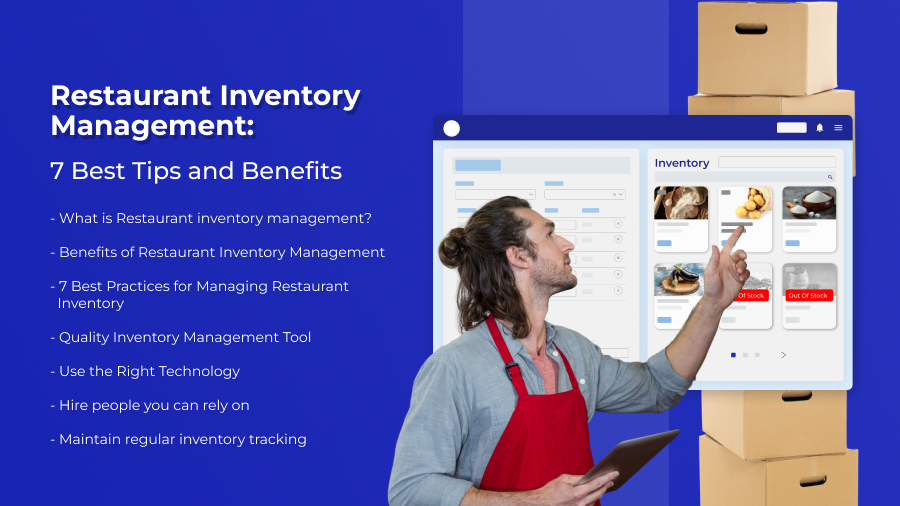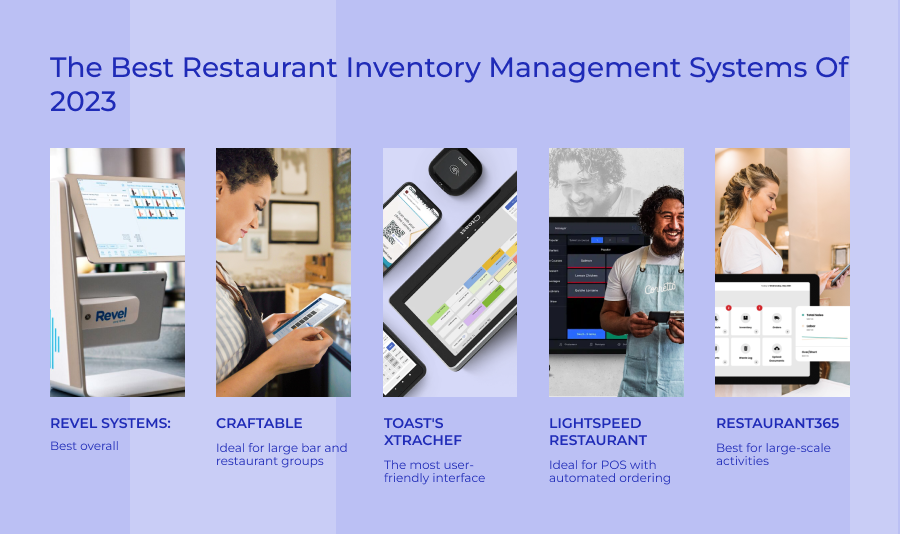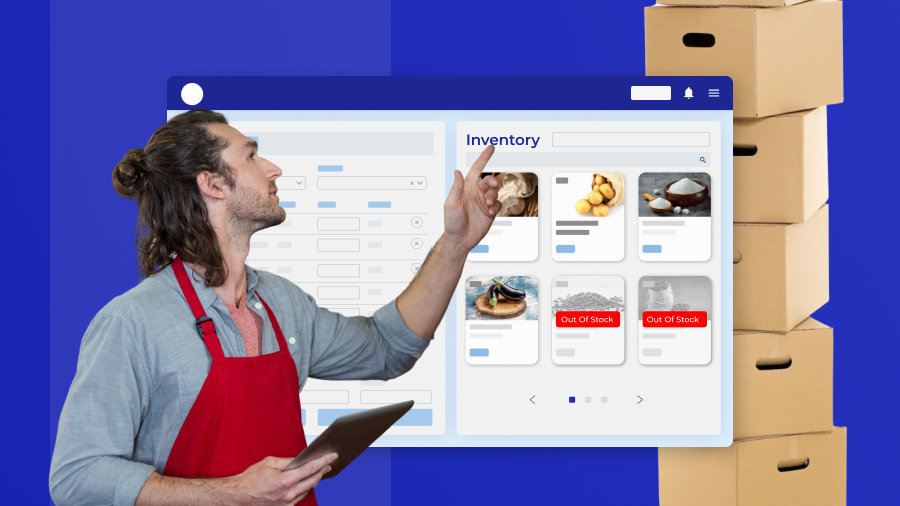Restaurant Inventory Management: 7 Best Tips and Benefits
The uncertainty of the economy and the ongoing inflation of food make it all the more important for restaurants to manage their inventory efficiently. Optimized restaurant inventory management is one of the most important levers operators can pull to track and control costs. A restaurant's inventory management is often time-consuming and complex.
It doesn't have to be that way! Restaurant inventory management software can make the process of managing restaurant inventory easier.
We have compiled 7 easy tips for managing restaurant inventory here.
Restaurants use food inventory management to source, track, and expense every ingredient. Like product inventory tracking in retail or fashion stores, food inventory in a restaurant must be monitored and measured.
A restaurant’s inventory management accomplishes three main tasks:
- Controlling and tracking food costs
- Always Tracking ingredient volume
- Controlling and tracking food waste

Benefits of Restaurant Inventory Management
Consider a restaurant that had no idea what menu items they had on hand. In rare cases, this could appear to be a cutting-edge farm-to-table experiment. However, most restaurants cannot function without inventory.
By using a restaurant inventory management system, restaurants can plan, create, serve, and advertise their menus. It prepares them to deliver dishes, drinks, and desserts without flinching in the face of unknown customer volume and order choices.
Inventory management in restaurants can help:
- Optimize food stock to improve profit margins
- Reduce food waste
- Forecast supply needs based on prior demand trends
- Automatically track food supply to minimize manual counting
7 Best Practices for Managing Restaurant Inventory
The significance of inventory management can lead one to believe that the process is tough, if not exhausting. Fortunately, this is not the case. With the correct tools and practices, restaurant inventory can be handled, allowing restaurants to resolve serious inventory concerns as soon as they develop.
When learning how to start your own restaurant business, restaurant inventory management should be your constant and one of your top objectives. This is something that restaurant owners can control. When they do, each menu item becomes fresher, the dumpster becomes lighter, and guests are happy to return.
With the right tools and processes, restaurant inventory can be managed effectively. This helps restaurants to resolve major inventory issues as soon as they arise.
Here are seven expert tips for managing restaurant inventory.
1. Quality Inventory Management Tool
Investing in quality inventory and kitchen management software is the finest investment a restaurant owner can make. Prior to software, restaurant operators were compelled to manually track food inventory.
While some still do (and manual tracking is useful in some instances), having automated restaurant management software is unrivaled in terms of efficiency and convenience.
Inventory management software can:
- Recommend which products to refill and when
- Predict which products will be popular later
- Automatically track inventory levels in real-time
- Track food waste and profitability
2. Use the Right Technology
When it comes to inventory management, restaurant inventory software is one of the best investments a restaurant can make. These software can be integrated with POS and ordering software to compare expected usage with actual usage, allowing managers to rapidly identify the source of any errors.
Furthermore, inventory management software frequently syncs with inventory ordering, making communication with vendors easier and faster than ever.
Restaurant365, for example, assists restaurants by improving inventory operations, whereas Backbar and Bevspot are good solutions for bars.
Key characteristics to look for in restaurant inventory software include:
- Menu engineering tools to determine menu item profitability.
- Calculate the food cost variance automatically.
- Integration with point-of-sale (POS) software and food vendors.
3. Hire people you can rely on
You can't be everywhere at once as a restaurant owner (no matter how much you try). That implies delegating food inventory to a trustworthy employee.
Inventory management is typically delegated to a restaurant manager or associate manager because they are expected to execute higher-level activities. Inventory levels are also useful for managers who control restaurant operations.
If you want to get into traditional restaurant ownership, maintain trustworthiness at the top of your hiring criteria. Delegate this vital task to a member of your team who has a great eye for detail and good math skills.
4. Maintain regular inventory tracking
An inventory management operation, like any well-oiled machine, necessitates consistency. Weekly inventory reviews are common in restaurants. Depending on consumer volume, inventory levels may be reviewed nightly.
By evaluating inventory levels, waste, and costs on a regular basis on the same day and time, you're more likely to get the most accurate picture of your kitchen. Reviewing the inventory count on a Sunday night one week against a Tuesday night the next week, for example, will not yield the same picture of low ingredients.
5. Set a backup system
While digital inventory management software is quite useful, issues do arise. If your inventory system fails, you must have a backup strategy in place to keep track of food while business continues.
An inventory sheet is the most effective method of manually tracking restaurant inventory. Inventory sheets can be kept on paper or in an excel spreadsheet and keep note of:
- The number or weight of each ingredient in the kitchen.
- Which ingredients are running short and require replenishment.
- Which ingredients must be purchased in the next buying round.
6. Learn from data trends
Whether you use a manual or automated inventory management system, these systems collect vital data for your food business. This data, like food, should not be thrown away.
Over the course of 6 to 12 months and beyond, an inventory management system can inform a restaurant about which ingredients are most popular, which ingredients are wasted the most frequently, and which dishes are profitable.
The idea here is to feed your inventory system constant, accurate data. The more you put into the system, the higher your profit margins can get.
7. Select an Inventory Costing Method
A business’s inventory costing approach is how it intends to transfer goods. In restaurants, the most prevalent strategy is First In, First Out (FIFO). Any inventory that arrives at the restaurant first must be sold first. FIFO ensures that ingredients are used while they are fresh- otherwise, a backlog of food would accumulate in the kitchen.
When it comes to presents and merchandise, restaurants may choose to reserve this and adopt Last In, First Out, where fresher inventory is sold first. This allows them to show off the latest designs of glassware, t-shirts, and other restaurant swag.

Best Restaurant Inventory Management Systems of 2023
The best restaurant inventory management systems of 2023 are:
- Revel Systems: Best Overall
- Craftable: Ideal for large bar and restaurant groups
- Toast's xtraCHEF: The most user-friendly interface
- LightSpeed Restaurant: Ideal for POS with automated ordering
- Restaurant365: Best for large-scale activities
- MarketMan: This is ideal for adding enhanced inventory to a POS
- TouchBistro: This is the best-value Ingredient tracking POS
- CrunchTime: Ideal for franchisees and multi-unit companies
- Orca: Best for sales-based cost forecasting
- Square: This is ideal for small cafes and food trucks

